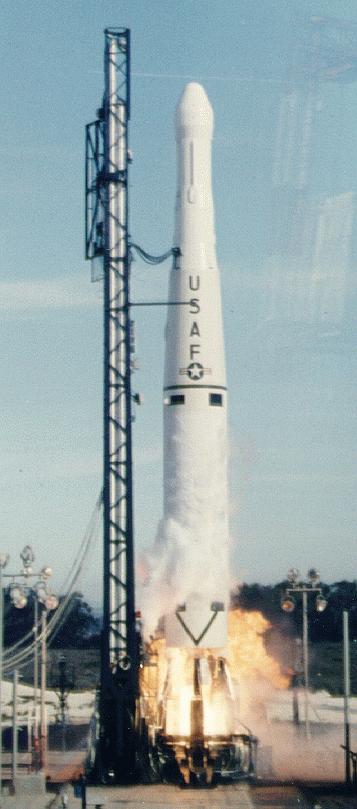Previous Spaceflight Launches
Filter by Agency, Locations or Vehicles
Show All LaunchesThor Agena A | Discoverer 12
McDonnell Douglas | United States of AmericaVandenberg SFB, CA, USA
June 29, 1960, 10 p.m.
Thor DM-21 Ablestar | Transit 2A
United States Air Force | United States of AmericaCape Canaveral, FL, USA
June 22, 1960, 5:54 a.m.
Status: Launch Successful
Mission:
The Transit system was the first satellite navigation system to be used operationally. The system was primarily used by the U.S. Navy to provide accurate location information to its Polaris ballistic missile submarines, and it was also used as a navigation system by the Navy's surface ships, as well as for hydrographic survey and geodetic surveying.
Polar OrbitAtlas Agena A | Midas 2
Convair | United States of AmericaCape Canaveral, FL, USA
May 24, 1960, 5:36 p.m.
Vostok 8K72 | Korabl'-Sputnik-1
RKK Energiya | RussiaBaikonur Cosmodrome, Republic of Kazakhstan
May 15, 1960, midnight
Thor Delta | Echo
McDonnell Douglas | United States of AmericaCape Canaveral, FL, USA
May 13, 1960, 9:16 a.m.
Status: Launch Failure
Mission:
The Echo 1 spacecraft was a 30.48 m diameter balloon of mylar polyester film 0.0127 mm thick. The spacecraft was designed as a passive communications reflector for transcontinental and intercontinental telephone (voice), radio, and television signals. It had 107.9 MHz beacon transmitters for telemetry purposes. These transmitters were powered by five nickel-cadmium batteries that were charged by 70 solar cells mounted on the balloon. Because of the large area-to-mass ratio of the spacecraft, data for the calculation of atmospheric density and solar pressure could be acquired. The spacecraft was also used to evaluate the technical feasibility of satellite triangulation during the latter portion of its life. Echo 1 failed during the coast period after launch, as the attitude control jets on the second stage failed and the spacecraft did not achieve orbit. Echo 1A was a successful relaunch.
Elliptical OrbitVostok-L 8K72 | Luna-4b
Energia | RussiaBaikonur Cosmodrome, Republic of Kazakhstan
April 16, 1960, 4:07 p.m.
Status: Launch Failure
Mission:
Luna 1960B was the third Soviet attempt to photograph the far side of the Moon, the first being the highly successful Luna 3 mission and the second being the unsuccessful Luna 1960A. Luna 1960B was launched on April 16, 1960. It was designed to replicate the Luna 3 mission, but with higher resolution cameras and a closer approach to the Moon.
Lunar flybyThor Agena A | Discoverer 11
McDonnell Douglas | United States of AmericaVandenberg SFB, CA, USA
April 15, 1960, 8:30 p.m.
Status: Launch Successful
Mission:
Discoverer 11 was an American optical reconnaissance satellite. The eighth of ten operational flights of the Corona KH-1 spy satellite series, it successfully employed the first space-worthy camera film; however, Discoverer's film return capsule was lost during reentry on 16 Apr when the satellite's spin motors exploded.
Low Earth OrbitVostok-L 8K72 | Luna-4a
Energia | RussiaBaikonur Cosmodrome, Republic of Kazakhstan
April 15, 1960, 3:06 p.m.
Status: Launch Failure
Mission:
Luna 1960A was the second Soviet attempt to photograph the far side of the Moon. The first being the highly successful Luna 3 mission. Luna 1960A was designed to replicate the Luna 3 mission, but with higher resolution cameras and a closer approach to the Moon.
Lunar flybyThor DM-21 Ablestar | Transit 1B
United States Air Force | United States of AmericaCape Canaveral, FL, USA
April 13, 1960, 12:02 p.m.
Status: Launch Successful
Mission:
The Transit system was the first satellite navigation system to be used operationally. The system was primarily used by the U.S. Navy to provide accurate location information to its Polaris ballistic missile submarines, and it was also used as a navigation system by the Navy's surface ships, as well as for hydrographic survey and geodetic surveying.
Polar OrbitThor Able II | Tiros 1
McDonnell Douglas | United States of AmericaCape Canaveral, FL, USA
April 1, 1960, 11:40 a.m.



